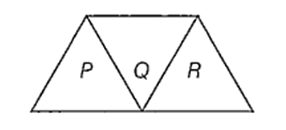 Multiple Choice Questions
Multiple Choice QuestionsA given ray of light suffers minimum deviation in an equilateral prism P. Additional prisms Q and R of identical

shape and material are now added to P, as shown in the figure. The ray will suffer
same deviation
greater deviation
total internal reflection
no deviation
A.
same deviation
Since prism P is placed in position of minimum deviation, therefore refracted rays becomes parallel to the base of the prism, again by adding two prism R and Q of same material as shown in figure, the deviation produced by Q and R are equal and opposite in sense, therefore final deviation is same as due to prism P.
The aperture of the objective lens of a telescope is made large so as to
increase the resolving power of the telescope
increase the magnifying power of the telescope
to focus on distant objects
make image aberrationless
A lamp hanging 4 metres above the table is lowered by 1 metre. The illumination on the table
decreased by 25%
increased by 25%
decreased by 66.7%
increased by 77.7%
In Young's double slit experiment, the fringe width is β, if the entire arrangement is placed in a liquid of refractive index n, the fringe width becomes
nβ
Yellow light is used in single slit diffraction experiment with slit width 0.6 mm. If yellow light is replaced by X-rays, then the pattern will reveal that
no diffraction pattern
that the central maxima narrower
less number of fringes
more number of fringes
In an interference experiment, third bright fringe is obtained at a point on the screen with a light of 700 nm. What should be the wavelength of the light source in order to obtain 5th bright fringe at the same point ?
630 nm
500 nm
420 nm
750 nm
If a ray of light in a denser medium enters into a rarer medium at an angle of incidence i, the angle of reflection and refraction are respectively r and r'. If the reflected and refracted rays are at right angles to each other, the critical angle for the given pair of media is
sin-1 (tan r')
sin-1 (tan r)
tan-1 (sin i)
cot (tan i)
The phenomenon of rotation of plane polarised light is called
Kerr effect
double refraction
optical activity
dichroism
As a result of interference of two coherent sources of light energy is
redistributed and the distribution does not vary with time
increased
redistributed and that distribution changes with time
decreased
There are n1 photons of frequency v1 in a beam oflight. In an equally energetic beam there are n2 photons of frequency v2. Then the correct relation
